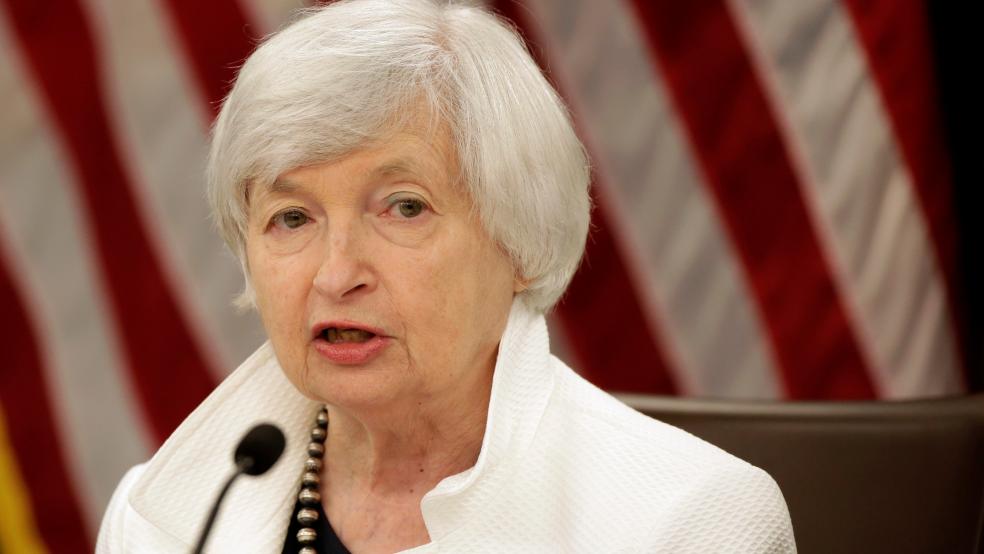All the talk, all the preparation, all the coddling by the Federal Reserve came to naught with the intrusion of a single economic report.
Not that financial markets were putting a high probability on the likelihood of a rate increase at this week's Fed meeting. But policy makers had been using their megaphones to make it very clear, at least in a central-banker-conditional sort of way, that it probably would be appropriate to raise interest rates in coming months. (I count three conditionalities in this oft-repeated guidance: "probably," "would be" and "in coming months.")
Yet with the surprisingly weak May employment report, all bets were off. Yes, Fed Chair Janet Yellen tried to put a happy face on paltry job growth, downward revisions to employment in prior months and a large exodus from the labor force at a speech in Philadelphia last week. But the rapid about-face left egg, not a smile, on the Fed's face.
Related: The Federal Reserve Bank, Explained
Why? Because it revealed the true meaning of data dependency (dependent on the most recent employment report); because it demonstrated that conducting forward-looking monetary policy depends on confidence in the Fed's forecast, which succumbs in the face of contradictory data on the current state of the economy; and because it exposed the Fed's true model as the attainment of astronomical perfection. For the Fed, the process of normalizing interest rates requires that all the stars be in perfect alignment.
In order to pull the trigger again following a single, 25-basis-point rate increase in December, the Fed needs signs of: continued improvement in the labor market; progress toward its medium-term goal of 2 percent inflation; a reversal in the trend of declining inflation expectations, both market- and survey-based; rising wages; narrowing credit spreads; and a U.S. dollar exchange rate that is not so strong as to depress exports. Before they act, policymakers want to be sure there is no financial market volatility anywhere in the world; no "uncertainty," such as the kind generated by the June 23 U.K. referendum on remaining in the European Union; and no negative developments in China or other large emerging market nations.
Related: Why Aren’t Presidential Candidates Talking About the Federal Reserve?
Have I left anything out? Having stated its intention in December to raise the fed funds rate four times this year, the Fed was forced to back-track, first because of a global stock-market rout in the first two months of the year; then because of weak first-quarter economic growth; and most recently because of news that employers added a total of 38,000 workers last month. Even without the depressing effect of the 35,000 Verizon workers on strike in May, revisions to prior months suggest a downshift in hiring. Economists are trying to determine whether the reason is inadequate labor supply, at least in terms of the skills employers are seeking, or weak labor demand.
Last year, it was more of the same, with domestic concerns or "financial and international developments" intervening to prevent the Fed from raising rates until its final meeting in December.
All this talk has become a distraction — and a source of embarrassment for the Fed. The markets have stopped listening, which defeats the whole purpose of forward guidance. During the Fed's May talk-a-thon, the probability of a June rate increase never exceeded 38 percent, according to the implied yield on fed funds futures contracts. Try as they might, Fed officials could not make a convincing case for a rate increase in July, if not in June.
Related: Pimco Warns 'Material Risk Globally' of Monetary Policy Exhaustion
Ultimately it is the market that decides when the central bank will move, according to Jim Bianco, president of Bianco Research. "The market has veto power over the Fed," he said, noting that since the Fed started announcing its funds rate target in 1994, it has never adjusted interest rates without the market first pricing in the move.
Fed policymakers have made it eminently clear that they really, really want to raise rates. Why there is such urgency isn’t as clear. One of Yellen's pet indicators, the Labor Market Conditions Index, has been declining since January. Introduced by the Fed in 2014, the LMCI melds 19 individual indicators into an index that presumably provides a composite assessment of the labor market.
Yellen has often said that the unemployment rate, at 4.7 percent in May, is not a good reflection of the available slack in the labor market because of the large number of Americans who have dropped out of the labor force in recent years. For that very reason, the LMCI includes variables such as the labor force participation rate, the quits rate and average hourly earnings to provide additional insight into the labor market.
"The Fed created it; now use it," said Michael Darda, chief economist at MKM Partners, in a note to clients last week, challenging the basis for the Fed's happy-talk on future rate increases.
Related: The Fed Should Wait for Clarity Before Raising Rates
Fed policymakers are gripped by fear that any unexpected rate increase will create absolute havoc in financial markets. At this point, such an outcome would be a blessing.
Imagine if the U.S. economy were to take off, driven by productivity-enhancing investment in new technologies. Real GDP growth starts rising at a 3 percent to 3.5 percent rate, inflation picks up, employers bid up the price of labor to meet demand for goods and services, and the Fed has to, yes, surprise the markets with a rate increase. Wouldn't that be lovely, or at least something completely different? We should be so lucky.





